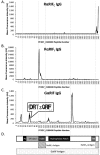Epitopes of anti-RIFIN antibodies and characterization of rif-expressing Plasmodium falciparum parasites by RNA sequencing
- PMID: 28233866
- PMCID: PMC5324397
- DOI: 10.1038/srep43190
Epitopes of anti-RIFIN antibodies and characterization of rif-expressing Plasmodium falciparum parasites by RNA sequencing
Abstract
Variable surface antigens of Plasmodium falciparum have been a major research focus since they facilitate parasite sequestration and give rise to deadly malaria complications. Coupled with its potential use as a vaccine candidate, the recent suggestion that the repetitive interspersed families of polypeptides (RIFINs) mediate blood group A rosetting and influence blood group distribution has raised the research profile of these adhesins. Nevertheless, detailed investigations into the functions of this highly diverse multigene family remain hampered by the limited number of validated reagents. In this study, we assess the specificities of three promising polyclonal anti-RIFIN antibodies that were IgG-purified from sera of immunized animals. Their epitope regions were mapped using a 175,000-peptide microarray holding overlapping peptides of the P. falciparum variable surface antigens. Through immunoblotting and immunofluorescence imaging, we show that different antibodies give varying results in different applications/assays. Finally, we authenticate the antibody-based detection of RIFINs in two previously uncharacterized non-rosetting parasite lines by identifying the dominant rif transcripts using RNA sequencing.
Conflict of interest statement
MW is a co-founder and board member of Modus Therapeutics AB, a company developing drugs for severe malaria. All other authors declare no financial conflicts of interest.
Figures




References
-
- Cheng Q. et al.. stevor and rif are Plasmodium falciparum multicopy gene families which potentially encode variant antigens. Mol Biochem Parasitol 97, 161–176 (1998). - PubMed
Publication types
MeSH terms
Substances
LinkOut - more resources
Full Text Sources
Other Literature Sources

